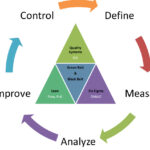Quality Circle (QC) is a small, voluntary group of employees and their supervisor(s), comprising a team of about 8 to 10 members from the same work area or department group of staff that meets regularly to solve problems relating to their job scope or workplace. QC works on the basis of a continuous and on-going process in an organization. Normally members of a particular QC come from the same workshop who face and share similar problems in their daily work life. Ideally, the group size should be seven or eight to give enough time to each member to actively participate and contribute in each meeting.
The philosophy is that everyone will take more interest and pride in their work if they have a share in the decision-making process or have a say in how their work should be conducted. QC gives employees greater satisfaction and motivation.
A man named Kaoru Ishikawa in Japan first developed quality circles in the 1960s. The Union of Japanese Scientists and Engineers (JUSE) were the ones who paid for the research that put the theories about behaviour science and quality control together.
Quality circles are useful because the members of the team are from the same workplace and face similar problems. This concept is a management tool that has many benefits for their own work environment. Some examples of those benefits are control and improvement of quality, more effective company communication, using employee problem solving capabilities and more job involvement.
Although the quality circle was developed in Japan, yet it spread to more than 50 countries, a development Ishikawa never foresaw. Originally, Ishikawa believed circles depended on factors unique to Japanese society. But after seeing circles thrive in Taiwan and South Korea, he theorized that circles could succeed in any country that used the Chinese alphabet. Ishikawa’s reasoning was that the Chinese alphabet, one of the most difficult writing systems in the world, can be mastered only after a great deal of study; thus, hard work and the desire for education became part of the character of those nations. Within a few years, however, the success of circles around the world led him to a new conclusion: Circles work because they appeal to the democratic nature of humankind. “Wherever they are, human beings are human beings,” Ishikawa wrote in a 1980 preface to the English translation of the Koryo.
In “How to Operate QC Circle Activities,” Ishikawa calls middle and upper management the parent-teacher association of quality control circles. Although circles were one of the earliest Japanese ideas about quality to be popularized in the West yet Ishikawa was always aware of the importance of top management support. Support from the top is a key element in Japan’s all-encompassing quality strategy: company-wide quality control (CWQC), perhaps best described in Ishikawa’s What is Total Quality Control? – The Japanese Way. Ishikawa’s work with top management and CWQC covered decades. In the late 1950s and early 1960s, he developed quality control courses for executives for top managers. He also helped launch the “Annual Quality Control Conference” for top management in 1963.
Concept
The concept of quality circle is primarily based upon recognition of the value of the worker as a human being, as someone who willingly participates in his job, his wisdom, intelligence, experience, attitude and feelings. It is based upon the human resource management considered as one of the key factors in the improvement of product quality and productivity. The concept of quality circle has three major attributes:
· Quality circle is a form of participation management
· Quality circle is a human resource development technique
· Quality circle is a problem-solving technique
Objective
The objectives of quality circles are multi-faced.
a) Change in Attitude
· From “I don’t care” to “I do care”
· Continuous improvement in quality of work life through humanization of work
b) Self Development
· Bring out “hidden potential” of people
· People get to learn additional skills
c) Development of Team Spirit
· Individual vs. team– “I could not do but we did it”
· Eliminate inter-departmental conflicts
d) Improved Organizational Culture
· Positive working environment
· Total involvement of people at all levels
· Higher motivational level
· Participate in management process
Benefits of Forming Quality Circles
The benefits gained through QC activities are as follows:
· Increase in quality consciousness of employees
· Development of an attitude of problem prevention
· Promotion of employee motivation
· Improvement in the human relations
· More effective company communication
· More active job involvement
· Utilization of employee problem solving capabilities
· Contribution to personal development of employees
· Encouragement of teamwork
· Improvement of work environment
· Development of safety awareness
· Control and improvement of quality
· Productivity improvement
· Increased job security
QC activities are voluntarily carried out as part of company-wide quality control.
It took more than two decades for the quality control concept to get acceptance in India after its introduction in Japan. This may be due to the differences in the industrial context in the two countries. Japan needed it for its survival in a competitive market. India had a reasonably protected, sellers’ market, with consequent lethargy toward efforts to improve quality and productivity. However, with the policy of liberalization of economy and privatization of infrastructure development, contexts changed. The concept now needs to be looked upon as a necessity.
The aim of quality circles is to inculcate effective team dynamics through communication, trust, shared vision, commitment, involvement, empowerment and learning culture among the staff.
The benefits are that QCs:
· Promote individual self-development
· Promote teamwork and fellowship
· Improve overall company performance and corporate image
Organizational Structure
The quality circle has an appropriate organizational structure for its effective and efficient performance. It varies from industry to industry, organization to organization. But it is useful to have a basic framework as a model. The structure of a quality circle consists of the following elements:
1. A Steering Committee
This is at the top of the structure. It is headed by a senior executive and includes representatives from the top management personnel and human resources development people. It establishes policy, plans and directs the program and meets usually once in a month.
2. Coordinator
He may be a personnel or administrative officer who coordinates and supervises the work of the facilitators and administers the program.
3. Facilitator
He may be a senior supervisory officer. He coordinates the works of several quality circles through the circle leaders.
4. Circle Leader
Leaders may be from lowest level workers or supervisors. A circle leader organizes and conducts circle activities.
5. Circle Members
They may be staff workers. Without circle members the program cannot exist. They are the lifeblood of quality circles. They should attend all meetings as far as possible, offer suggestions and ideas, participate actively in-group process and take training seriously with a receptive attitude.
The roles of steering committee, coordinator, facilitator, circle leader and circle members are well defined.
Launching Quality Circles
The major prerequisites for initiating quality circles in any organization is the total understanding of as well as complete conviction and faith in the participative philosophy, on the part of the top and senior management. In the absence of a commitment from the chief executive to support the quality circle movement totally, it would be inadvisable to seriously attempt the starting of quality circles.
The launching of quality circles involves the following steps:
a. Expose middle level executives to the concept.
b. Explain the concept to the employees and invite them to volunteer as members of quality circles.
c. Nominate senior officers as facilitators.
d. Form a steering committee.
e. Arrange training of coordinators, facilitators in basics of quality circle approach, implementation, techniques and operation. Later facilitator may provide training to circle leaders and circle members.
f. A meeting should be fixed preferably one hour a week for the quality circle to meet.
g. Formally inaugurate the quality circle.
h. Arrange the necessary facilities for the quality circle meeting and its operation.
Training
Appropriate training for different sections of employees needs to be imparted. Without a proper understanding of the real concept of Quality Circles, both the workers and management might look at this philosophy with suspicion. Each group should know beforehand the commitments and implications involved as well as the benefit that can be obtained from quality circles.
Such training comprises of the following:
· Brief orientation program for top management
· Program for middle level executives
· Training of facilitators
· Training for circle leaders and members
Process of Operation
The operation of quality circles involves a set of sequential steps as follows:
1. Problem identification– Identify a number of problems by Brainstorming
2. Problem selection– Decide the priority by using appropriate tools like Pareto Analysis, Ranking Method and select the problem to be taken up first.
3. Problem analysis– Problem is clarified and analysed by basic problem-solving methods like Ishikawa Diagram, Data Collection and Analysis, Process Flow Diagrams, Histograms & Scatter Diagrams..
4. Generate alternative solutions– Identify and evaluate causes and generate number of possible alternative solutions by Brainstorming..
5. Select the most appropriate solution– Discuss and evaluate the alternative solutions by comparison in terms of certain Criteria’s for e.g. Investment and return from the investment, cost benefit analysis, safety etc. This enables to select the most appropriate solution.
6. Prepare plan of action– Prepare plan of action for converting the solution into reality which includes the considerations “who, what, when, where, why and how” of solving problems.
7. Present solution to management for approval. 8. Implementation of solution– The management evaluates the recommended solution. Then it is tested and if successful, implemented on a full scale.


